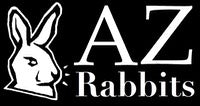
It's possible for a husband and wife to maintain a herd of up to 1,000 does.
- Dr. Lukefahr
____________________________________________
The following "rabbit facts" were taken from C. Park Romney's book, Raising Rabbits at Home:
- One doe can produce 70-110 lbs. of dressed meat each year.
- Rabbits are multipurpose animals. They are used for meat, fur, wool, laboratory experiments, etc.
- They are raised in all 50 states.
- There are over 50 known breeds of rabbits.
- Presently over 200,000 families raise rabbits.
- Only 500 to 600 does provide full-time employment.
- There are over 300 different recipes for rabbit.
- Rabbit wool is lighter and warmer than any other animal wool.
- After slaughter 93% of the entire carcass is useable.
- Only about 7% of the rabbit consists of bone.
- Rabbits have no diseases communicable to humans.
- Most felt hats are made from rabbit pelts.
- Rabbit fur can duplicate 85% of all other furs.
- Rabbit meat helps stomach disorders.
- The rabbits foot has been a good luck charm for centuries.
- Gardeners will virtually beg for rabbit manure as plant food.
- Rabbits are the only edible farm animal abel to produce 1,000% of it's own weight in offspring per year.
- They are the cleanest of all vegetarians.
- They can produce a litter in only one month's time.
- They can breed all year around.
- Some people claim rabbits are rodents. They aren't; they are lagomorphs.
- Rabbit manure is almost odor free if kept fairly dry.
- Rabbit manure will not burn plants even when applied fresh.
- Rabbits won't crow, bark or howl at the moon at midnight or any other time.
- Domestic rabbit meat does not have a strong or wild taste.
- Rabbits can begin reproducing by 4 to 5 months of age.
- In 1/70 of an acre about 5 tons of rabbit meat can be produced annually.
- Raising rabbits requires a very low investment.
- Geologists claim that rabbits are opossums and are the oldest known living mammals.
- Rabbits have been reported to weigh up to 26 lbs.
____________________________________________
Rabbit Populations
In 2000 - 2001, the following statistics were estimated:
- Rabbit dispatched for meat consumption: abt 2 million rabbits
- Rabbits kept as pets: abt 5.28 million rabbits
- Rabbits used in laboratories: over 250,000 rabbits
- FFA & 4H projects: abt 1 million rabbits
- Hobby breeders: abt 930,000 rabbits
- Total estimated domestic rabbit population in US: 9 million rabbits

- U.S. Rabbit Industry Profile
- USDA:APHIS:VS - Centers for Epidemiology and Animal Health Center for Emerging Issues
____________________________________________
Rabbit Industry
In 2000 - 2001, the following statistics were estimated:
- Meat rabbit marketing: $7 to $8 million (compared to $41 billion for cattle industry)
- Rabbit meat retail sales: Between $16 and $20 million
- Pet rabbit supply sales: $612 million (of the total $75 billion pet supplies industry)
- Total rabbit industry value: $745 - $831 million
- U.S. Rabbit Industry Profile
- USDA:APHIS:VS - Centers for Epidemiology and Animal Health Center for Emerging Issues
____________________________________________
Rabbitry Operating Costs
In 2000 - 2001, the following statistics were estimated:

As is seen through the above chart, rabbitries do not appear to have the advantages of economies of size and scale at the production levels usually considered in the U.S.
Litters of 8 to 10 kits are optimal for commercial production.
Some experts suggest 35 fryers per doe annually are needed just to cover operation costs. Others argue that 44 per doe are needed to cover costs.
- U.S. Rabbit Industry Profile
- USDA:APHIS:VS - Centers for Epidemiology and Animal Health Center for Emerging Issues
____________________________________________
Other Interesting Facts...
Wild Rabbits vs Domestic Rabbits
Did you know that domestic rabbits cannot breed with wild rabbits in the United States? That includes cotton tails, jackrabbits, etc. They aren't the same genus/species. Their gestation period, maturity age, breeding practices, eating habits and even the taste of their meat is different.
Wild rabbits also cannot be domesticated (besides the fact that it's illegal). They will never lose the fear of humans and most often will end up dying in a cage. And domestic rabbits will almost always die if set free in the wild.
On the other hand, domestic rabbits CAN breed with wild rabbits in Europe!
____________________________________________
The following table shows the Laboratory Industry Group - Research Facilities, Breeders and Dealers


1 - The number of rabbits is the number that was used in research in 1999.
2 - The number of rabbits is the inventory at last inspection
Sources: USDA, APHIS, Animal Care and USDA, NASS


